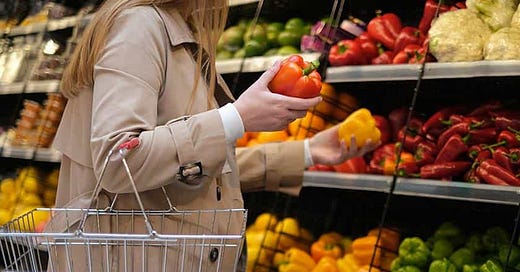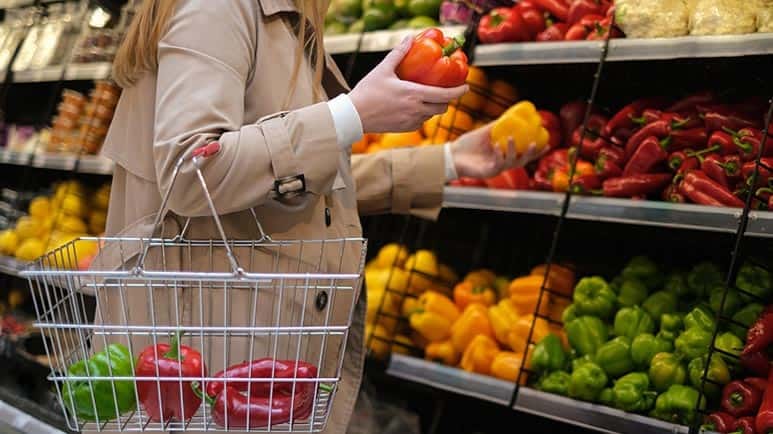How to Pick the Best Produce at the Grocery Store
Believe it or not, only 1 in 10 adults eat the amount of produce recommended daily to stay healthy and avoid disease. Could it be that people aren't sure what produce should look and feel like?
STORY AT-A-GLANCE
A government report reveals that in 2015, only 9% of adults consumed an adequate amount of vegetables, only 12% ate enough fruit and the lowest intake was among men, young adults and adults living in poverty
Failing to eat the recommended dietary allowance of vegetables and fruits increases your risk for several of the most common chronic diseases, such as diabetes, obesity and heart disease
Some fruits and vegetables were bred for appearance rather than flavor, and the result became a mealy, tasteless, altogether disappointing piece of produce
Appearance and aroma are two ways to judge how fresh produce is when buying, but remember: Beauty is only skin deep
Editor's Note: This article is a reprint. It was originally published December 9, 2017.
If you've ever been to a grocery store and picked up produce, you've more than likely opened a package or two and found yourself stuck with rubbery carrots, mealy apples or muskmelon that was either mushy or hard as a rock.
Fruits and vegetables that disappoint once you get them home may have something to do with the fact that, more often than not, it's not kids who have to be prodded to eat their fruits and vegetables, it's adults (and if adults don't think it's important, chances are they aren't influencing their kids to do so).
In fact, a report1 from the U.S. Centers for Disease Control and Prevention (CDC) reveals that only 1 in 10 adults eat the fruits and veggies they need. The CDC recommends adults eat at least one and one-half cups to two cups of fruit per day, and two to three cups of vegetables.
The report notes that in 2015, only 9% of adults in the U.S. got an adequate amount of vegetables, and an average of 12% of adults ate enough fruit. Study results also showed that the lowest averages for produce consumption were among men, young adults and adults living in poverty. Lead study author Seung Hee Lee-Kwan, Ph.D., of CDC's division of nutrition, physical activity and obesity, commented:
"This report highlights that very few Americans eat the recommended amount of fruits and vegetables every day, putting them at risk for chronic diseases like diabetes and heart disease. As a result, we're missing out on the essential vitamins, minerals, and fiber that fruits and vegetables provide."2
How to Pick the Ripest Fruit and the Freshest Veggies
You've heard it before — "What you see is what you get." That's not necessarily true with produce, though. In fact, researchers have discovered a fairly predictable reason why Americans, especially, tend to reach for something other than plant-based foods.
The reason, the study at the University of Florida Institute of Food and Agricultural Sciences discovered, is simply that people aren't exactly sure how to pick what's good and what might not be best in the flavor, freshness and texture categories when they find themselves standing in front of a produce table.
Researchers perused the surveys that 1,200 study consumers filled out regarding what generally caused them to choose six different types of produce, and found that appearance and aroma are the two most common determining factors. But when they use that model and choose a good one, it's just chance, the scientists say.
Men's Fitness3 explains that besides looking over the produce, using your nose is a better gauge for peak ripeness and taste. Today suggests three rules that will help you pick the tastiest tomatoes and perfectly ripened pears:
Beautiful doesn't always mean it will taste good
Use your hands to help determine freshness
Shop for produce that's currently in season
Also, beware of genetically engineered fruits and vegetables, which tend to be more heavily contaminated with pesticides such as glyphosate. Examples best avoided include Arctic apples, engineered to resist browning when cut.
Shipping and Shelf-Life Impact Produce Quality
One reason appearance isn't a good way to figure out what produce is best is that over decades, some fruits and vegetables, like Red Delicious apples, for instance, were bred to be beautiful rather than have a pleasing flavor and consistency, and the result became a mealy, tasteless, altogether disappointing piece of fruit.
When choosing fruits and vegetables, such as pears, strawberries, squash or sweet potatoes, picking it up and considering its weight may help you pick the best as well as its fragrance. Today notes three reasons why shopping for produce that's in season (and avoiding the ones that aren't) is wise:
"In the Golden Age of the American supermarket, Chilean tomatoes and South African asparagus are an arm's length away when our soil is blanketed in snow. Sure, sometimes you just need a tomato, but there are three persuasive reasons to shop in season: it's cheaper, it's better and it's better for you."4
Below are some helpful suggestions for how to select high-quality produce. You could call these directives the "ABCs" of picking produce.
The 'A's' Have It — How to Buy These Fruits and Veggies
Apples should be smooth, firm and heavy for their size without bruising (they bruise easily), nicks in the flesh, wormholes or brown streaks. The smaller they are, the more flavorful they'll be. Peak season is September to May. Place them in your fridge's crisper drawer in a brown paper bag away from vegetables to keep several weeks.
Artichokes aren't typically the most sought-after produce, perhaps because consumers are unsure what to look for. They should have tightly closed leaves when ripe, have deep green color, feel heavy and show no mars in the flesh. Peak season is March to May. Refrigerate up to five days in a brown paper bag.
Don't 'B' Missing Out on These
Bananas are sometimes a matter of taste in regard to how yellow they are, but they're sweetest when they're speckled with small brown spots. If they're streaked with brown and the spots are large, pass them by. Never refrigerate them; store them at room temperature on the counter. These also are in season year-round, and can be "bagged" to speed up ripening.
Beets are gaining in popularity, but don't have to be the tennis ball-sized nuggets some believe are best. Even large beets can be firm and delicious if they're stored properly. They should be unblemished, firm and deep red that doesn't yield when pressed with your thumb. The leaves should be vibrant, not wilted.
Peak season for beets is June to October. Remove the leaves, but leave about four inches of the stems so the beets will retain their deeper red color when cooked. Store them in the refrigerator in a brown paper bag for no more than two days or the crisper for up to two weeks; otherwise they become rubbery.
Broccoli should be firm, not rubbery, with tightly packed clusters that are deep green or with a purple tinge, but not yellow. Peak season is from October to May. Place them in a bag to store in the fridge for up to a week.
Brussels sprouts are somewhat like mini cabbages, only milder. They should be a vibrant green, firm and compact. They're easiest to cook if you choose heads that are of similar size, but note that smaller ones have a sweeter flavor. These are best around October and November. To keep water from damaging their freshness, don't wash them before storing them in a paper bag in your refrigerator, where they will keep for up to two weeks.
Berries can be a challenge. Even when refrigerated they may go bad within a day or two. One of the key strategies is to make sure the berries, whether they're blueberries, raspberries or strawberries, are dry when you buy them. When they're wet, they can deteriorate and mold seemingly overnight.
Alleviate this problem by soaking them in a vinegar and water solution — four parts water and one part vinegar, MasterClass5 advises. Soak them for 20 minutes in the vinegar bath, then rinse in fresh, cold water to remove the vinegar.
You'll 'C' Peak Season Freshness Pays Off in Flavor
Cantaloupes are a little tricky to pick, but here's a trick — besides having a smooth indentation on the stem end, when pressing it firmly with your thumb, it should give just slightly. That tells you where it is in the ripening process. If it's soft anywhere, it's too ripe and will probably be mushy. It should also be pleasantly fragrant. To keep cantaloupes from losing their flavor, store them in the refrigerator until you're ready to eat them — up to five days.
Carrots should be smooth and bright orange (or one of the other vibrant colors they come in) and so firm they threaten to snap rather than bend. Your best bet, year-round, is to select carrots with their green, feathery leaves still attached. Remove the greens before storing them in a bag in your crisper drawer for up to three weeks.
Cauliflower is exploding in popularity since people have discovered it can be an excellent stand-in for pizza crust and even mashed potatoes. When shopping for this white veggie, make sure you don't see little black flecks, and that the stems and florets are firm, not rubbery. At their peak, from September to November, refrigerate them unwashed in a plastic bag for up to a week. If light brown or black spots form, shave them off with a sharp knife.
If you're in doubt about what's in season, when, check out seasonalfoodguide.org.6 Simply select your state from the dropdown menu and the month in question to get a list of fruits and veggies that are in season in your local area.
Gathering your produce for soups, stir-fries, fruit and veggie trays and just for good, fresh eating, buying foods when they're in season ensures the best flavor, best texture and also the best in all the vitamins, minerals and multiple phytonutrients fruits and vegetables offer.
Disclaimer: The entire contents of this website are based upon the opinions of Dr. Mercola, unless otherwise noted. Individual articles are based upon the opinions of the respective author, who retains copyright as marked.
The information on this website is not intended to replace a one-on-one relationship with a qualified health care professional and is not intended as medical advice. It is intended as a sharing of knowledge and information from the research and experience of Dr. Mercola and his community. Dr. Mercola encourages you to make your own health care decisions based upon your research and in partnership with a qualified health care professional. The subscription fee being requested is for access to the articles and information posted on this site, and is not being paid for any individual medical advice.
If you are pregnant, nursing, taking medication, or have a medical condition, consult your health care professional before using products based on this content.






